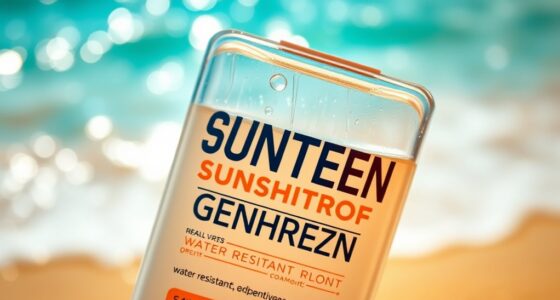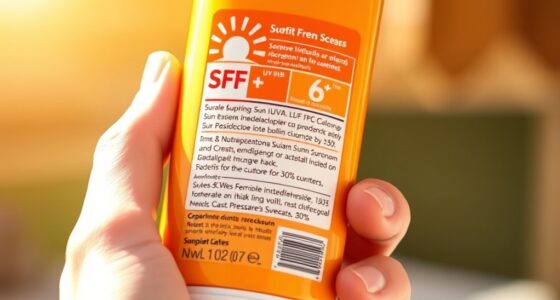Swimming pools can double your sun exposure because water reflects up to 80% of harmful UV rays. To stay safe, apply a broad-spectrum sunscreen with at least SPF 30 before hitting the water. Make sure the sunscreen is water-resistant, ideally lasting 40 to 80 minutes, and reapply every two hours or right after swimming. Protect yourself further by seeking shade during peak hours and staying hydrated. Also, consider wearing a wide-brimmed hat and UV-blocking sunglasses. Following these tips can help you enjoy the sun while minimizing risks—there's more essential info to keep you protected ahead!
Key Takeaways
- Water reflects up to 80% of UV rays, significantly increasing sun exposure while swimming.
- Apply broad-spectrum sunscreen with at least SPF 30, 20-30 minutes before entering the water.
- Choose water-resistant sunscreens that last 40 to 80 minutes in water for effective protection.
- Reapply sunscreen every two hours or immediately after swimming or towel drying to maintain coverage.
The Magnifying Effect of Water
When you jump into a pool, the water can reflect up to 80% of harmful UV rays, dramatically increasing your sun exposure while you swim. This reflection means that while you're enjoying the cool water, you're also at risk of receiving double the UV exposure compared to being on dry land. In fact, if you don't protect yourself, you could absorb up to 90% of your daily UV exposure in just a few hours of swimming.
It's important to remember that even on cloudy days, UV rays can penetrate through the clouds, so you're not safe from skin damage just because it's overcast.
To safeguard your skin, always apply broad-spectrum sunscreen with at least SPF 30 before you plunge into the water, and don't forget to reapply every two hours, especially after swimming. Additionally, wearing protective clothing, like rash guards or swim shirts, can offer extra coverage against those sneaky UV rays.
Why Traditional Sunscreens Fail

Traditional sunscreens often fall short in protecting your skin during swimming because they can wash off quickly in water, leaving you vulnerable to harmful UV rays. Many conventional sunscreens lack adequate water resistance, which is essential for anyone who spends time in pools or the ocean. When you're in and out of the water, you need a product that can hold up against the elements.
Moreover, not all traditional sunscreens provide broad-spectrum protection against both UVA and UVB rays. This is critical because both types of UV rays can contribute to skin damage and increase your risk of skin cancer. If you apply too little sunscreen or don't allow enough time for it to absorb, you're setting yourself up for potential harm.
Additionally, some ingredients in traditional sunscreens can irritate sensitive skin or even pose a threat to marine ecosystems. This highlights the significance of considering safer, reef-friendly alternatives that offer reliable protection without compromising your skin or the environment.
Best Sunscreen for Swimmers

Choosing the right sunscreen for swimming is vital to guarantee your skin stays protected from harmful UV rays while enjoying the water. To keep your skin safe, consider these important factors:
- Opt for water-resistant sunscreens that last 40 to 80 minutes in the water.
- Look for broad-spectrum sunscreen to shield against both UVA and UVB rays.
When selecting a sunscreen with an SPF, make certain it meets your needs. Applying about one ounce (the size of a shot glass) assures full-body coverage, including often-missed areas like your ears and the back of your neck.
Regular reapplication is vital; do it every two hours or immediately after swimming or towel drying to maintain best protection.
Tips for Safe Pool Parties

To guarantee everyone enjoys the pool party safely, prioritize sun protection and hydration for all attendees. The sun's rays can be deceptive, especially with UV radiation reflecting off the water. Here are some essential tips to keep everyone safe:
| Time of Day | Activity | Sun Protection Tips |
|---|---|---|
| Before 10 AM | Swimming | Apply broad-spectrum sunscreen (SPF 30) |
| 10 AM – 4 PM | Breaks under shade | Provide umbrellas or canopies |
| After 4 PM | Evening games | Reapply sunscreen every 2 hours |
| Throughout the day | Hydration | Keep water available |
| All day | Protective gear | Use wide-brimmed hats and UV-blocking sunglasses |
Encourage your guests to wear protective clothing and reapply sunscreen, especially after swimming. Establish shaded areas for breaks from the sun, allowing everyone to recharge safely. By following these tips, you'll ascertain everyone has a blast while staying protected from harmful UV radiation. Enjoy your pool party while keeping safety a top priority!
Educating Others on Sun Safety

Regularly educating others about sun safety is essential for preventing harmful UV exposure, especially in pool settings where reflection can intensify risks. By sharing important information, you can help create a safer environment for everyone enjoying the water.
Here are some key points to focus on:
- Highlight the dangers: Explain how water reflection can double UV exposure, increasing the risk of sunburn.
- Promote sunscreen use: Encourage applying broad-spectrum sunscreen with SPF 30 or higher at least 20-30 minutes before swimming for effective protection.
Teach children to recognize sunburn signs and stress the importance of seeking shade or wearing protective clothing during peak hours (10 AM – 4 PM).
Additionally, share credible resources like CDC and NFCR guidelines to provide evidence-based information.
By actively educating those around you about sun safety, you play a significant role in protecting them from harmful UV rays and promoting healthy habits that can last a lifetime.
Let's work together to make poolside fun safe!
Frequently Asked Questions
How Do You Stay Safe From Sun Exposure?
To stay safe from sun exposure, apply broad-spectrum sunscreen, wear protective clothing, and seek shade during peak hours. Keep reapplying sunscreen every two hours, and educate others about sun safety to enhance everyone's protection.
Does Being in a Pool Protect You From the Sun?
You might think a pool offers a cool escape from the sun, but it doesn't shield you. Water reflects UV rays, meaning you're still exposed. Always apply sunscreen, even when you're making a splash!
How Do I Protect My Skin From the Sun in My Pool?
To protect your skin from the sun in the pool, apply broad-spectrum sunscreen with at least SPF 30, reapply every two hours, wear protective clothing, and seek shade during peak sun hours.
What Is the Best Material to Protect You From the Sun While You Swim?
"An ounce of prevention is worth a pound of cure." To protect yourself from the sun while you swim, choose tightly woven polyester or nylon fabrics with high UPF ratings. They'll keep you safe from harmful UV rays.
What Are the Best Ways to Stay Safe from Sun Exposure While Using a Swimming Pool?
When it comes to staying safe from sun exposure while using a swimming pool, it’s important to follow some sun protection secrets celebrities swear by. Wear a broad-spectrum sunscreen, reapply it every 2 hours, wear a wide-brimmed hat, and seek shade during peak sun hours. These simple steps can help protect your skin.
Conclusion
As you immerse yourself in summer fun, remember that water acts like a magnifying glass, intensifying the sun's rays.
Just like a knight donning armor before a battle, you need your sunscreen as your shield. Choose a reliable product, reapply often, and don't forget those shaded areas.
By taking these precautions, you can enjoy your poolside adventures without falling victim to sunburn.
So gear up, stay safe, and make the most of every sunlit moment!









